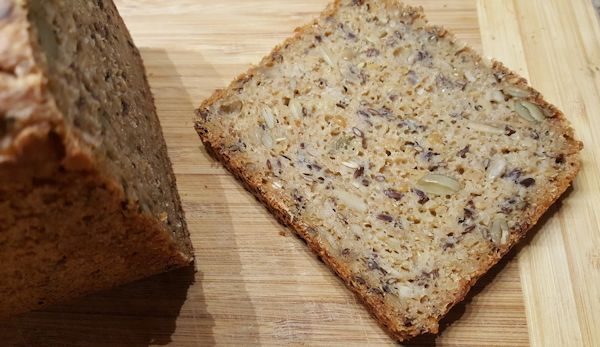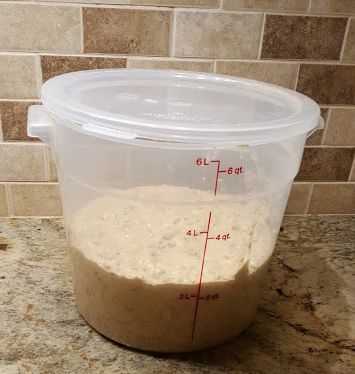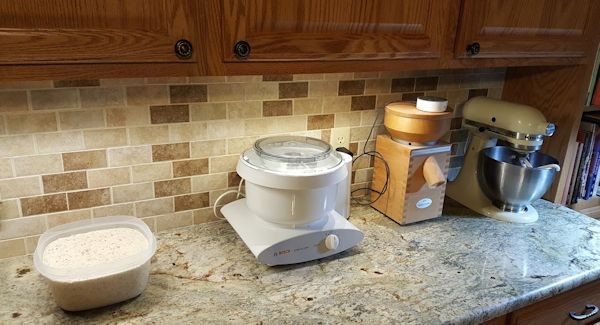Yesterday’s bread turned out awesome! It’s a delicious (very!) bread but if you can’t eat seeds and nuts, this is not the bread for you!
The outside is crunchy, while the crumb is moist and a bit chewy with all the seeds. It makes the most amazing toast. This is the recipe I used for the German Seeded Bread.
As far as supplies, I used my long Pullman Pan.
One pan is a 9″ x 4″ and one is a 13″ x 4″. In recipes that call for a 9″ x 5″ bread pan, the 9″ x 4 is too small. 9 x 4 = 36 square inches of baking space. 9 x 5 = 45 square inches and 13 x 4 = 52″ inches of baking space so it isn’t that great of an increase. By using the longer pan, I get a shorter loaf (height) which gives us smaller pieces of bread which is better for our diets. I do have to adjust the baking times.
The Pullman Pans come with a lid. Some breads need a little steam. If you don’t want to be adding steam to the oven, that’s when the lid works and creates steam within the pan. I don’t always use the lid but it’s nice when I need it. I also like the straight edges of the Pullman pan (as opposed to a regular loaf pan where the edges are a bit slanted.
When baking bread I always use an instant read thermometer and begin checking the internal temp of the bread once the top begins get close to looking done. Say the recipe says to cook in a 9″ x 5″ pan for 90 minutes. If using the 13″ x 4″ pan, I will set the oven timer for 75 minutes, which is about the same percentage of time less, as the percentage of difference between the sizes of the pans. I shoot for an internal temp of 200°. Others go for a bit higher. Make sense? If not, then you’re probably not the only one who doesn’t understand what I’m saying so ask and I’ll try to explain myself better.
The big container for the dough is a dough bucket and that’s available at Breadtopia. I keep a second one of those on my counter for the scraps that need to go into the compost bin.
The seeds/nuts are things you can buy locally or on your next trip to a city – flax seeds, pumpkin seeds, sunflower seeds – any kinds of seeds you want to use really.
As far as grains, there are many places that sell grains. If you live near a Whole Foods, you can buy many grains in whatever quantities you want from their bins. If your only choices is mail order, shipping is going to be expensive but Pleasant Hill Grain is always my go to choice but that’s buying grains in bulk – usually 25+ pounds at a time. Most grains are shipped in food grade buckets with oxygen absorbers. Amazon sells grains (check the ratings). I’ve had good luck buying smaller quantities from Blue Bird Grain (they’re very fast with shipping but again, the shipping is costly). Breadtopia is also a good source for grain and you can buy in smaller or larger quantities.
If you’re going to be buying whole grains, you’re going to need a way to grind it. There are lesser expensive (though still expensive) grain mills. I started out with a Family Grain Mill, which was on the lower end and used it a lot over 6 or 7 years before buying the KoMo Fidibus Classic. This is a blog post I did a few years back when folks were asking about the grain mill. There are several links within that post that you may find helpful.
In early 2015, I ordered the KoMo Fidibus Classic. That’s an Amazon affiliate link and you can read the reviews there but Pleasant Hill Grain and Breadtopia also sell them. The VitaMix blender and maybe others will also grind wheat but I have not tried that so I can’t vouch for the results.
There are several reasons I switched over to the KoMo, but there are less expensive mills that will work just fine. The KoMo produces an amazingly fine flour .. powdery fine. It also has about 5 times more settings than does my Family Grain Mill. It is quieter. The hopper will hold more grain and it grinds more quickly. I had been grinding grain/corn long enough that I knew it would be a worthwhile investment. I would not have started out with this as my first grinder though.
Not required but if you find that you enjoy making whole grain breads, most typical kitchen mixers aren’t up for that job on a long term basis. I have one of the old Kitchen Aids from the early 80’s when Hobart still made them and it’s a work horse but I needed something more so I bought the Bosch mixer in 2008 and I have loved it for making bread . . not so much for cookies and cakes. Here’s a blog post I did about the Bosch. It’s an old post and the pictures may not load.
These are the items that stay on my countertop these days. Far right is the old Kitchen Aid, then the KoMo grinder and the left gadget is the Bosch mixer. It seems expensive but when you figure the cost of a good, grainy bread and I’ve been using it 8 years and have no reason to believe it won’t last 8 more years .. it’s a pretty good investment.
Have I covered everything? If not, and if you have questions, please leave a comment and I’ll answer them here.





Sherrill Pecere says
Judy!!! You are a bread GENIUS!!
JudyL says
Thanks, but not really. After tasting really good bread, it’s hard to eat most store bought breads so I do what I have to do.
Swooze says
Yeah I have a question. Can you send me a loaf??? Lol
JudyL says
You never know when I’ll end up in your neck of the woods and I might just bring you a loaf!
Diane says
Thank you so much for answering my questions about the supplies you use. I make bread all the time, chesse and caraway seed, braided parmesan, white, etc. I would love to start making wheat and sourdough. Living in Michigan mean to this family, homemade bread and stews and soups in the winter. So thank you again.
JudyL says
If you have any other questions, holler. If I can’t answer them, I’ll find someone who can. Several of my friends are real baking pros and know way more than I do.
Rebecca in SoCal says
I didn’t see any link for the Bosch mixer, so went to Amazon. They have several on sale now, and I did notice “cookie paddle” in the lists of accessories. Too bad my husband just doesn’t eat bread; I can’t justify the cost of one for just myself.
Funny thing: the ad banner at the top of the Amazon Bosch mixer page was for the KitchenAid stand mixers.
JudyL says
Even with the cookie paddle, it’s not a mixer I would recommend for cookie dough.
Rebecca in SoCal says
I looked at the recipe, and see she buys grains in bulk as you mentioned. Knowing you don’t have a basement, what do you do with whole grains that must be kept cool and dry? (I really wish there were a way to make a cool place without refrigeration for we who can’t have basements.)
JudyL says
I store bulk grains in 5 or 6 gallon tubs with gamma seal lids and oxygen absorbers. They stay in the sewing room and we keep the air conditioner running almost year round.